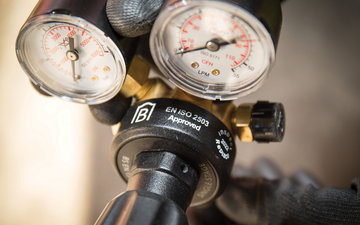- Official BOC UK Online | Industrial Gases | Products & Solutions | BOConline UK
-
Shop
- Industries
- Processes
- Gases & Equipment
-
Solutions
-
Services
-
Health & Safety
-
Contact & Support
- What's Happening
-
Net Zero Strategies
Arc Welding: Getting Gas Flow Right can Make or Break your Weld
Posted by BOC

Setting shielding gas flow correctly is one of the most vital aspects when setting up to TIG or MIG weld, and a key factor in whether the completed weld is sound. Use a flow rate that’s too low or too high and you could run into problems.
There are several important aspects to take into consideration with shielding gas flow, from choosing the right rate to checking for leaks.
Why do I need to use the right gas flow rate?
The correct shielding gas flow is necessary to shield the weld pool from atmospheric contamination, to ensure quality and integrity of the welded joint, and to avoid a number of common welding defects that could arise.
If you don’t use the correct gas flow rate it may lead to problems with your weld. These include atmospheric contamination, which raises oxidation in the weld metal. This, in turn, can lead to problems with porosity, or other issues such as excess spatter.
With some gases, you may also have trouble sustaining a weld arc. In addition, a flow rate that is higher than is actually required will waste gas and increase your costs.
A gas cylinder isn’t the only thing to focus on when you’re trying to set the right shielding gas flow rate. Wire speed, consumables and other aspects of your weld set-up can all have an impact. On top of all this, flow rates can differ depending on the welding task at hand.
Choosing the right shielding gas flow rate for your weld
As you might have already gathered there’s more to choosing a gas flow rate than meets the eye. You’ll need to consider:
- If you are working to a welding procedure, then refer to it - it should define the flow rate range you should be working to
- The type of gas you’re using – some gases, e.g. those containing helium, are less dense and this can impact the accuracy of the flow rate reading in your flowmeter. Whether a gas is heavier or lighter than air can also be an important consideration
- Weld material thickness – in general, thinner metal requires a lower flow rate, with the opposite being true for thicker material
- Welding torch nozzles size/diameter - the bigger the nozzle generally the higher the shielding gas flow rate
- As a general rule of thumb for MIG welding, 1l/min of gas flow rate should be used for every millimeter of nozzle diameter. For example, if you are using a16mm diameter MIG nozzle, then generally 16 l/min of shielding gas flow will suffice
- Typically for MIG welding, 15-20 l/min will suffice and for TIG welding 6-10 l/min
- Your welding application – typically, manual tasks need a lower flow rate, while automated or mechanised work requires a higher flow
- Using a pea shooter flow indicator to check the shielding gas flow rate at the nozzle is the most accurate method.
Checking for gas leaks is vital
Despite your best preparations, it is possible that a gas leak may be present before you begin work, or at some point during your welding activity.
Fortunately, detecting a leak is quite straightforward.
One of the best ways to go about this is to use an approved leak detection fluid, such as Teepol Leak Detector Solution which is available to buy in your local Gas & Gear store and online. You should always double check via advice from the manufacturer that a detector solution is okay to use with your welding equipment.
Always avoid using soapy water/washing-up liquid for this task as it is not oxygen compatible and can cause stress corrosion cracking on parts.
When the cylinder and regulator are adjusted to the correct working pressure, spray the detection fluid around the connection joints, but not inside the valve outlet. If the fluid bubbles, then you have identified a gas leak.
The indicator on your gas flow meter can also be a useful tool to use. If it is showing a clear sign of flow when no welding is taking place, you have a leak.
If you find a leak, you should turn the cylinder off, ensure the gas hose is purged of pressure and check and retighten the relevant joint. Wipe away any of the detection fluid that’s left on the equipment.
Finally, ensuring that all cylinder valves are closed when you’re not using them is not only a good way to avoid leaks but is good safety practice as well.
If you need any further advice or you’re in any doubt about choosing your gas flow rate or detecting leaks, contact your local Gas & Gear store, or contact us via Live Chat.
Please note: this guide specifically relates to MIG/MAG/ TIG welding and shielding gas flow rates only.
You can find more hints and tips on gas flow, leak detection and how to set up your shielding gas cylinder and regulator in our video ‘An Introduction to MAG Welding – Setting up your Workspace, Cylinder & Regulator’.
Please note: cookies must be enabled to view the video. If you do not see the video, please click on ‘Cookie Settings’ and enable Cookies in your browser.

